What is Voice of the Customer (VoC): A Detailed Analysis
- May 23, 2024
- 15 mins read
- Listen

Consumers today are more demanding than ever. They have more choices than ever. As a result, they expect more from businesses. Listening to their voice is vital to understanding their needs and pain points. It’s equally important to empathize with their concerns and implement their feedback. To achieve all this, you first need to hear the voice of the customer (VoC).
Hearing the VoC is a strategic approach to gaining valuable insights into their needs and prioritizing their satisfaction. The more you listen to the voice of your customers, the better knowledge you can gain about your service effectiveness and product performance. This will also help you identify areas for improvement and innovation.
In this blog, we will explore the voice of the customer (Voc) concept in detail, analyze its elements, understand the benefits, and many other things.
But first, let’s get started with the definition first…
What is Voice of the Customer (VoC)?
The Voice of the Customer (VoC) is a strategic approach to hearing and capturing customers’ preferences and expectations. It refers to the process of collecting and analyzing customer feedback to understand their perceptions and experiences with a product, service, or brand.
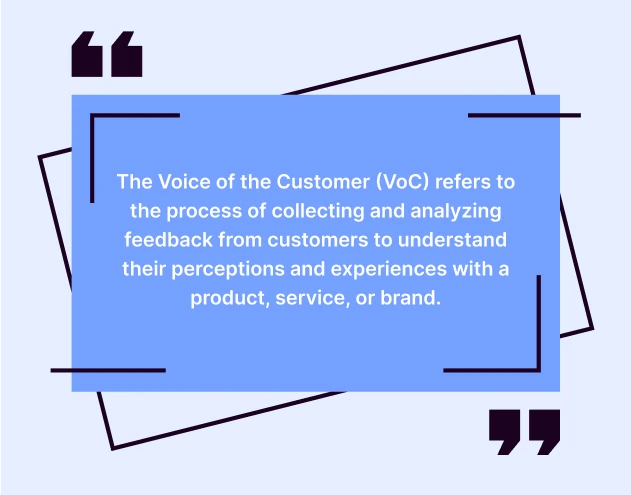
VoC aims to identify what customers expect and value so that their overall experience with the brand can be enhanced. Its ultimate goal is to align business strategies with customer needs, resulting in better performance and satisfaction.
A business that listens to the voice of the customer can create more personalized services and experiences, thereby fostering long-term relationships with customers. More so, it’s essential for meeting and exceeding customer preferences that lead to success over time.
Voice of the Customer ( VoC ) Key Elements
VoC has a big significance in improving business performance and customer loyalty. It can be used to deliver the kind of services expected by customers. However, successful implementation of the voice of the customer needs a proper understanding of its elements, which include –
- Customer Feedback Collection – Collecting customer feedback through various channels is essential to understanding their experiences and expectations with products or services.
- Data Analysis – A business needs to analyze all the data and feedback collected from the customer to get insights into common trends and prioritize areas for improvement.
- Customer Journey Mapping – It’s important to map out the customer journey to know the touchpoints that are adding or diluting customer satisfaction with your brand.
- Proactive Measures – Analyzing historical data and trends is essential for addressing customer issues proactively and achieving higher satisfaction with preemptive solutions.
- Cross-Functional Collaboration – Customer needs are best fulfilled when different departments such as marketing, customer service, sales, and product development work with a shared vision.
- Continuous Improvement – Listening to the voice of the customer is never an on-off event; it’s rather a continuous process that you need to follow to stay abreast of the evolving needs and preferences.
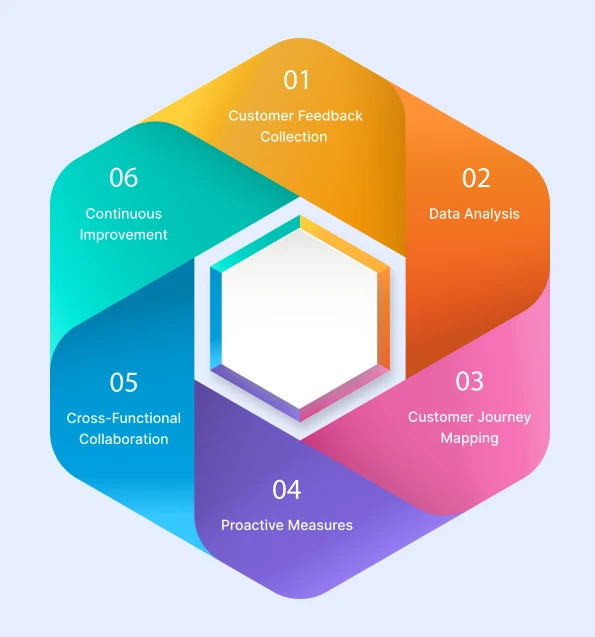
Benefits of Voice of the Customer Program
VoC offers numerous benefits that can directly impact a business’s performance and customer relationships. Continuously listening to customers and implementing their suggestions is vital to achieving targets easily and staying ahead of others.
Here are some key benefits of the voice of the customer –
- Higher Customer Satisfaction Levels – A business that actively listens to customer feedback and acts upon the inputs can better meet expectations and achieve higher levels of customer satisfaction.
- Enhanced Customer Loyalty – Customers feel happy and valued when their feedback is implemented. They may show more loyalty and make repeat purchases from a business that cares for their voices.
- Reduced Churn Rates – Loyal customers stick with the business for longer. They are also less sensitive to price changes. Most importantly, they won’t churn easily and this can contribute to improved profit and revenue for the business.
- Value to Product Development and Innovation – VoC gives key insights into customer likes and dislikes. This information can prove valuable in product development and innovation.
- Superior Customer Experiences – Businesses that leverage VoC are better placed to deliver improved experiences to their customers. This can be a big competitive advantage in the market.
- Efficient Operations – Having a good understanding of customer issues and pain points can help remove bottlenecks from various processes and systems. This can lead to efficient operations characterized by fewer complaints and reduced costs.
- Better Decision-Making – VoC data and information can serve as a framework for making informed business decisions. It ensures that decisions are grounded in customer feedback and they are more likely to resonate with customers.
- Personalized Communication – Voice of the Customer program offers detailed insights into consumer behavior and preferences. These insights can be used to tailor the interactions and offerings, ensuring more personalized experiences for customers.
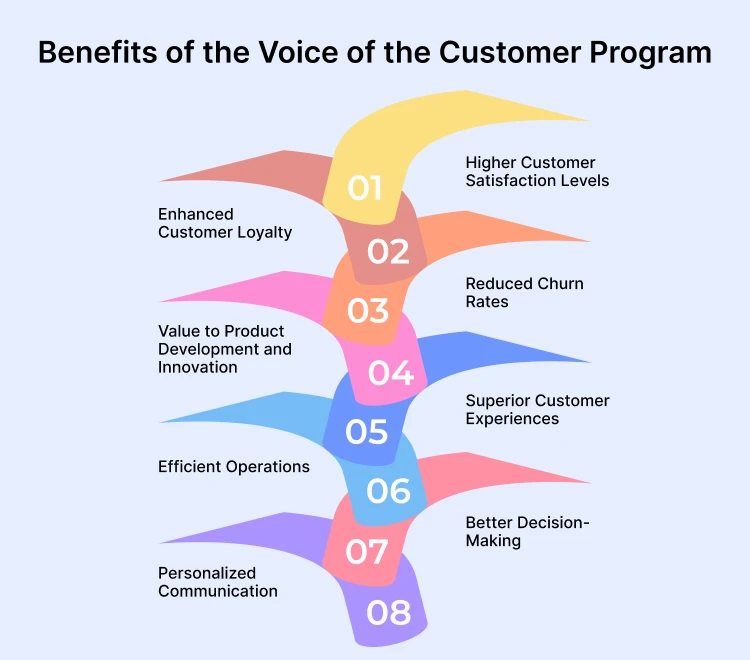
Common Challenges of Voice of the Customer Program
Implementing a VoC program can provide tons of benefits to the business. However, it comes with several challenges that need to be addressed to ensure success. This is how a more effective program can be developed.
Here are the key challenges of VoC:
- Data Overload – A VoC program necessitates collecting data and information from multiple channels. This can sometimes result in data overload. Many businesses often fail to effectively organize, analyze, and manage vast amounts of data, leading to faulty insights.
- Quality of Feedback – Customer data and information may not always be accurate and representative. Their accuracy and quality also depend on the survey designs and questions. That’s why sometimes unreliable data compromise the effectiveness of a VoC program.
- Delayed Action – While most businesses regularly collect feedback from customers, not all take timely action. Delays in action are quite common with feedback that results in a loss of customer confidence in the business.
- Lack of Resource Allocation – A VoC program can be beneficial and successful only when the business invests in technology, tools, and personnel. Contrary to popular wisdom, there is always a challenge in allocating resources and justifying the investment to stakeholders.
- Inadequate Employee Participation – A voice of the customer program delivers desired results only when all employees understand its value and support it. For most businesses, getting people engaged is a challenge that results in poor execution of the program.
- Unmeasured Impact – Neither deploying clear metrics nor quantifying the impact of changes is a common challenge faced with the VoC program. This program stops businesses from leveraging the full potential of the program.
- Privacy Concerns – Not many businesses adhere to the privacy and security concerns that come with collecting and handling customer data. When there is a lack of compliance with data protection regulations, it may lead to a loss of customer trust.
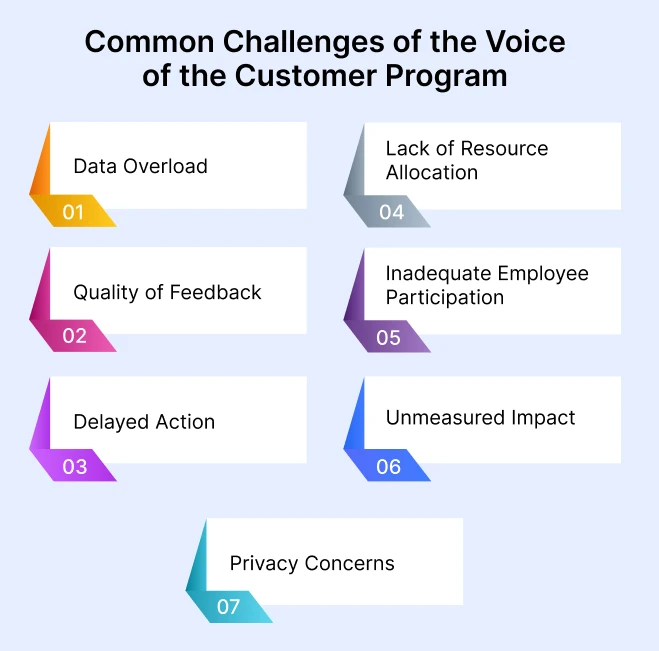
Key Stats on Voice of the Customer ( VoC )
- Listening to the voice of the customer can help you deliver great services. After all, 86% of shoppers are willing to pay a premium for great customer service. ( Source – PwC )
- Customers feel valued when their feedback is valued and acted upon. 52% of people believe that companies need to take action on customer feedback. ( Source – Microsoft )
- Not paying heed to a customer’s voice can be a big reason for not meeting customer needs successfully. 89% of consumers have stopped doing business with a company after a negative customer experience. ( Source – Salesforce )
- The more a business listens to the customer’s voice, the better service it can deliver. Companies that lead in customer experience outperform laggards by nearly 80%. ( Source – Forbes)
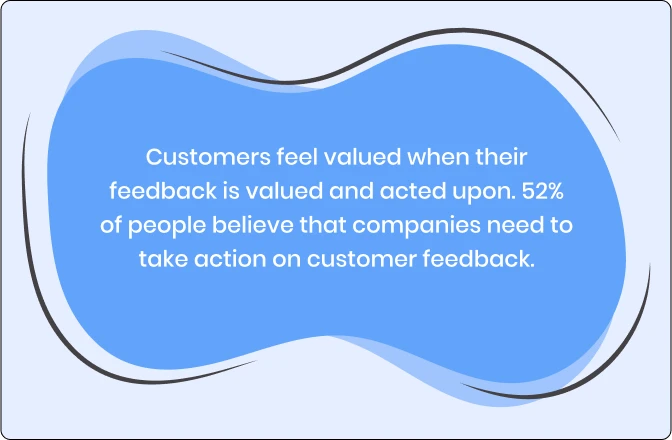
How to Build a Voice of the Customer Program?
A voice of the customer program can help your business gain data-driven insights about customer needs and preferences. It can also help you understand how customers interact with your product or services. That’s why you should take care and follow the right steps to build a successful VoC.
Here are the steps to build a voice of the customer program –
Step 1. Establish Program Objectives and Goals
Before building a VoC program, you need to define clear goals and objectives to be achieved. You need to be clear about what you want from the program – to address customer issues, enhance product usability, or gain insights for future development. Based on that, you can create a roadmap for the program.
It’s equally important to get input from a diverse group of stakeholders. Make sure people from different departments, from sales, marketing, product development, and support, are part of the steps to establishing goals.
Key Features
- Specify clear criteria of success for your VoC program
- Use performance metrics to ensure the program aligns with your overall business goals
- Create a balanced approach to address both short-term and long-term goals
Step 2. Define the Target Audience and Customer Segments
What next after you have set goals for your VoC program? The next step is to define your target audience and customer segments. It will guide your program in the right direction. The goals you have set for your program will be key in defining the target audience and segments you want to focus on.
Analytics can also be valuable in defining the target audience. You can analyze data collected at various touchpoints to understand the kind of issues your customers face. Such an analysis will also be useful for devising the right course of action for your audience.
Key Strategies
- Use customer data to segment the audience based on purchase history, demographics, and other useful criteria
- Create detailed customer personas representing different segments and use them for preparing a robust feedback mechanism
3. Employ the Right Research Methods and Tools
Using the right mix of quantitative and qualitative methods is key to the effectiveness and success of a VoC program. Unless you choose the right research methods and tools, there won’t be clear insights about customer behavior and preferences. These methods and tools can help you collect data with ease and analyze them efficiently.
The methods and tools you select must align with your VoC program goals. It will let you get a holistic knowledge of the customer’s voice. The tools and research methods you select will be key to measuring specific aspects of customer experience, such as their satisfaction levels and probability of recommending your brands to others.
Key Features
- Use surveys and questionnaires to collect numerical data
- Gain deeper insights into customers with interviews and focus groups
- Analyze customer behavior through website analytics
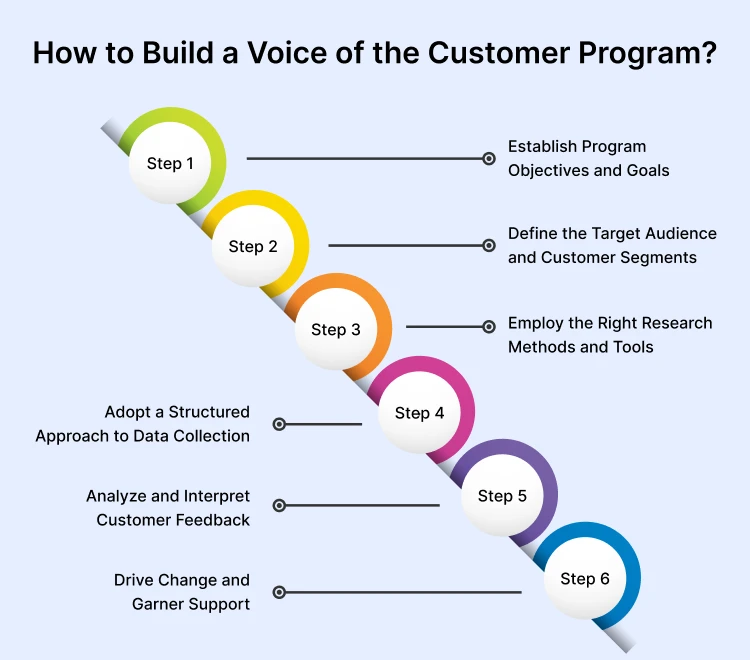
Step 4. Adopt a Structured Approach to Data Collection
It’s important to employ a structured approach to data collection. Doing this will ensure consistency and reliability with customer feedback data. The key is to collect relevant information systematically to gain insights into customer experiences and preferences with your brand, product, or service.
The focus should be on gathering vital data points and minimizing biases that often creep into surveys, questionnaires, or focus groups. In addition, you also need to analyze and compare data across touchpoints and customer segments to get value with your data collection efforts.
Key Features
- Develop a user-friendly feedback mechanism
- Use consistent scales and questions across different channels to get actionable and comparable data
Step 5. Analyze and Interpret Customer Feedback
When you’re building a voice of the customer program, data collection is not the end of the road. You need to go a step ahead – you also need to analyze and interpret that data. This step is essential for distilling valuable insights from the collected data.
Analyzing and interpreting customer feedback will help you gain deep knowledge of customer pain points and preferences. You will also understand emerging trends and actions you need to implement. This step can serve as a framework to guide decision-making for product improvements.
Key Features
- Identify trends and correlations using methods like sentiment analysis
- Leverage text and thematic analysis for open-ended responses
Step 6. Drive Change and Garner Support
All the insights gained from the VoC program must be shared across various levels of the organization. This will help keep everyone in the loop and prepare the roadmap for implementing changes. Your stakeholders must be part of the strategies for driving change.
Key Strategies
- Prepare detailed reports and presentations for stakeholders
- Present data in a visual and engaging form by using charts, graphs, and infographics
- Regularly update the stakeholders about the progress and changes
Voice of the Customer Best Practices
Implementing a robust and effective Voice of the Customer (VoC) program involves strict adherence to several best practices. This is how a business can capture customer feedback accurately and drive relevant changes.
Let’s look at some of the VoC best practices –
- Ensure that your VoC program is in alignment with your overall business objectives.
- Regularly track the success and performance of your program by defining specific and measurable goals.
- Garner support from senior management so that resources and commitment to the program are always there.
- Identify key touchpoints and map out the entire customer journey to understand when and where to collect feedback.
- Use multiple channels and methods to collect feedback, and ensure the feedback mechanism is easy for customers to comprehend.
- Focus on designing effective surveys that help you gather both quantitative and qualitative data.
- Include only relevant questions and keep the survey short and concise to boost completion rates.
- Categorize your audience to different segments and take steps to understand the preferences of each category.
- Always acknowledge customer feedback and show them that their voice is heard and acted upon.
- Foster a customer-centric culture and train your employees to prioritize feedback and insights.
- Regularly track the impact of changes made based on customer feedback you collect.
- Consider the VoC program an ongoing process and always look to refine its key elements.
- Present all the data and insights in easy-to-understand forms so that stakeholders can get help in the decision-making process.
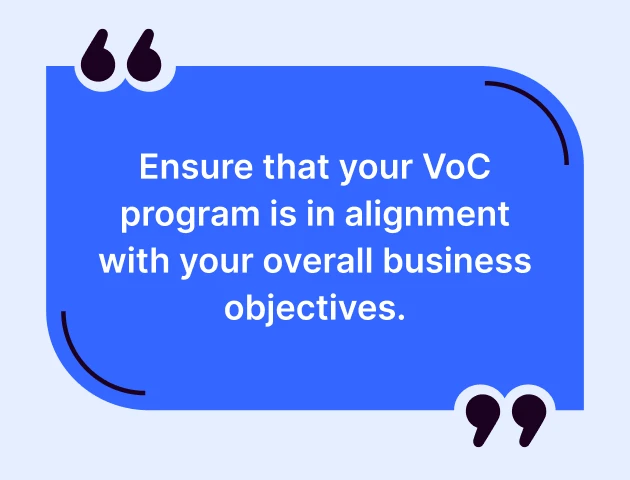
Voice of Customer Examples
1. Amazon’s Post-Purchase Surveys
The retail industry is a good place to find lots of VoC examples. Popular retailer Amazon regularly sends post-purchase surveys and encourages customers to share their overall shopping experience with the brand. The survey also asks about product satisfaction and the quality of delivery service. This survey is then used to identify areas for improvement.
2. Toyota’s Follow-Up Calls
Top automotive company Toyota is known for following up with customers regularly. Every time a customer pays a service visit, the company reps connect them through calls or emails to ask about their service experience. The goal is to listen to the voices of the customers and understand how they feel about the brand and services. The follow-ups help Toyota improve its processes and tweak customer service strategies for an improved experience.
Many brands are also turning to live chat for automotive industry to offer instant, personalized support that enhances post-service engagement and satisfaction.
3. Microsoft’s In-App Feedback and Surveys
Tech giant Microsoft shows the importance of paying heed to the voice of the customer regularly. It uses UX surveys and in-app feedback mechanisms to collect inputs on new features and software updates. The goal is to collect user insights on product usability. It helps the software development teams to fix bugs, enhance user interfaces, and develop features aligning with customer expectations.
4. Citi Bank’s NPS Surveys
Citi Bank is always one step ahead of others in using the power of surveys to gauge customer satisfaction levels. It stands out for using Net Promoter Score (NPS) surveys to gauge customer loyalty. The survey asks customers how likely they are to recommend the bank and its services to others. A follow-up question follows the survey to know the reason for the rating. This strategy is key for the bank to devise strategies for enhancing customer satisfaction.
Listen to the Voice of the Customer and Boost Engagement with REVE
Engaged customers feel happier and stick for longer with a brand. They spend more and turn into advocates over time. This shows how engagement is the basis of success for a business. The more you engage, the better you can serve your customers.
We, at REVE Chat, realize the value of engaging with customers, listening to their voice, and offering them value at each stage of their journey with your brand.
Your business can rely on our engagement tools and cater to customer needs perfectly. Our AI-powered chatbot can help you add speed to responses and minimize wait times. You can automate routine tasks using the bot.
For visual engagement, we have video chat software and co-browsing features.
You can add our live chat software and chatbot to enhance the quality of support and improve the overall customer experience with your brand.
So, sign up with us and check how our tools can add value to your business.




